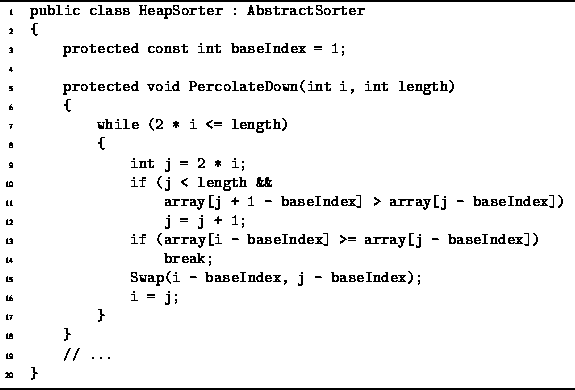|
Data Structures and Algorithms
with Object-Oriented Design Patterns in C# |
In the first phase of heapsort,
the unsorted array is transformed into a max heap.
Throughout the process we view the array as a complete binary tree.
Since the data in the array is initially unsorted,
the tree is not initially heap-ordered.
We make the tree into a max heap from the bottom up.
That is, we start with the leaves and work towards the root.
Figure ![]() illustrates this process.
illustrates this process.

Figure: Combining heaps by percolating values.
Figure ![]() (a) shows a complete tree that is not yet heap ordered--the root is smaller than both its children.
However, the two subtrees of the root are heap ordered.
Given that both of the subtrees of the root are already heap ordered,
we can heapify the tree by percolating
the value in the root down the tree.
(a) shows a complete tree that is not yet heap ordered--the root is smaller than both its children.
However, the two subtrees of the root are heap ordered.
Given that both of the subtrees of the root are already heap ordered,
we can heapify the tree by percolating
the value in the root down the tree.
To percolate a value down the tree,
we swap it with its largest child.
For example, in Figure ![]() (b) we swap 3 and 7.
Swapping with the largest child ensures that after the swap,
the new root is greater than or equal to both its children.
(b) we swap 3 and 7.
Swapping with the largest child ensures that after the swap,
the new root is greater than or equal to both its children.
Notice that after the swap the heap-order is satisfied at the root,
but not in the left subtree of the root.
We continue percolating the 3 down by swapping it with 6
as shown in Figure ![]() (c).
In general, we percolate a value down either until it arrives in
a position in which the heap order is satisfied
or until it arrives in a leaf.
As shown in Figure
(c).
In general, we percolate a value down either until it arrives in
a position in which the heap order is satisfied
or until it arrives in a leaf.
As shown in Figure ![]() (d),
the tree obtained when the percolation is finished is a max heap
(d),
the tree obtained when the percolation is finished is a max heap
Program ![]() introduces the HeapSorter class.
The HeapSorter class extends the AbstractSorter class
defined in Program
introduces the HeapSorter class.
The HeapSorter class extends the AbstractSorter class
defined in Program ![]() .
The PercolateDown method shown in Program
.
The PercolateDown method shown in Program ![]() implements the algorithm described above.
The PercolateDown method takes two arguments:
the number of elements in the array to be considered, n,
and the position, i, of the node to be percolated.
implements the algorithm described above.
The PercolateDown method takes two arguments:
the number of elements in the array to be considered, n,
and the position, i, of the node to be percolated.

Program: HeapSorter class PercolateDown method.
The purpose of the PercolateDown method is to transform the subtree rooted at position i into a max heap. It is assumed that the left and right subtrees of the node at position i are already max heaps. Recall that the children of node i are found at positions 2i and 2i+1. PercolateDown percolates the value in position i down the tree by swapping elements until the value arrives in a leaf node or until both children of i contain smaller value.
A constant amount of work is done in each iteration. Therefore, the running time of the PercolateDown method is determined by the number of iterations of its main loop (lines 7-17). In fact, the number of iterations required in the worst case is equal to the height in the tree of node i.
Since the root of the tree has the greatest height,
the worst-case occurs for i=1.
In Chapter ![]() it is shown that the height of a complete binary tree
is
it is shown that the height of a complete binary tree
is ![]() .
Therefore the worst-case running time
of the PercolateDown method is
.
Therefore the worst-case running time
of the PercolateDown method is ![]() .
.
Recall that BuildHeap calls PercolateDown
for ![]() .
If we assume that the worst-case occurs every time,
the running time of BuildHeap is
.
If we assume that the worst-case occurs every time,
the running time of BuildHeap is ![]() .
.